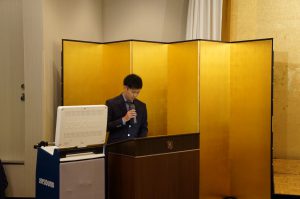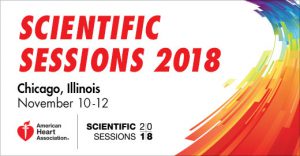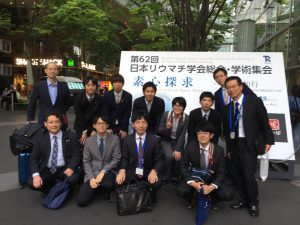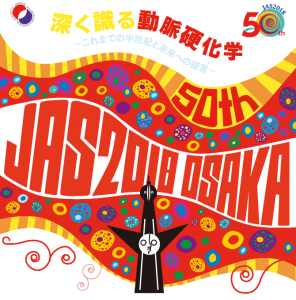 Early endothelialization associated with a biolimus A9 bioresorbable polymer stent in a porcine coronary model
Early endothelialization associated with a biolimus A9 bioresorbable polymer stent in a porcine coronary model
Mori M, Sakata K, Nakanishi C, Nakahashi T, Kawashiri MA, Yoshioka K, Takuwa Y, Okada H, Yokawa JI, Shimojima M, Yoshimuta T, Yoshida S, Yamagishi M, Hayashi K.
Heart Vessels. 2017 May 17. ![]()
Impact Factor (2016): 3.434
Abstract
Although Nobori®, with a bioresorbable polymer and biolimus A9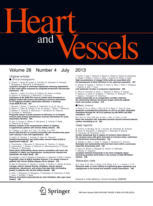 abluminal coating, has unique characteristics, few data exist regarding endothelialization early after implantation. Fifteen Nobori® and 14 control bare-metal stents (S-stent™) were implanted in 12 pigs. Histopathology of stented segments, inflammation, and intimal fibrin content was evaluated on the 2nd and 14th day after implantation. On the 2nd day, endothelial cells were morphologically and immunohistologically confirmed on the surface of both stents, although some inflammatory cells might be involved. Stent surface endothelialization evaluated with a scanning electron microscope showed partial cellular coverage in both stents. On the 14th day, neointimal thickness and percentage of the neointimal area were significantly lower in Nobori® than in S-stent™ (51.4 ± 4.5 vs. 76.4 ± 23.6 µm, p < 0.05 and 10.8 ± 2.6 vs. 14.1 ± 4.2%, p < 0.01). No significant differences were found in these parameters on the 2nd day (17.3 ± 14.9 vs. 26.7 ± 13.6 µm and 3.7 ± 3.0 vs. 6.7 ± 3.7%), in inflammatory and intimal fibrin content scores. These results demonstrate that endothelialization could occur early after Nobori® implantation with similar inflammatory reaction to bare-metal stents, probably contributing to low frequency of in-stent thrombosis and restenosis.
abluminal coating, has unique characteristics, few data exist regarding endothelialization early after implantation. Fifteen Nobori® and 14 control bare-metal stents (S-stent™) were implanted in 12 pigs. Histopathology of stented segments, inflammation, and intimal fibrin content was evaluated on the 2nd and 14th day after implantation. On the 2nd day, endothelial cells were morphologically and immunohistologically confirmed on the surface of both stents, although some inflammatory cells might be involved. Stent surface endothelialization evaluated with a scanning electron microscope showed partial cellular coverage in both stents. On the 14th day, neointimal thickness and percentage of the neointimal area were significantly lower in Nobori® than in S-stent™ (51.4 ± 4.5 vs. 76.4 ± 23.6 µm, p < 0.05 and 10.8 ± 2.6 vs. 14.1 ± 4.2%, p < 0.01). No significant differences were found in these parameters on the 2nd day (17.3 ± 14.9 vs. 26.7 ± 13.6 µm and 3.7 ± 3.0 vs. 6.7 ± 3.7%), in inflammatory and intimal fibrin content scores. These results demonstrate that endothelialization could occur early after Nobori® implantation with similar inflammatory reaction to bare-metal stents, probably contributing to low frequency of in-stent thrombosis and restenosis.
背景
狭心症・心筋梗塞の治療として経皮的冠動脈ステント留置術が広く行われるようになりデバイスも日々進歩しています。薬剤溶出性ステントの登場により、ステント内再狭窄はベアメタルステントと比較して10%以下に減少してきました。しかしながら、ステントに塗布されている薬剤・ポリマーによる炎症反応が遷延することで血管修復反応(内皮化)が遅延し、遠隔期にステント内血栓症を認めることが問題となっています。
薬剤溶出性ステントであるNoboriは、薬剤・ポリマーがステントの血管壁接着面のみにコーティングされており、全周性コーティングと比較して薬剤・ポリマーの量が少なく、ステント留置後比較的早期に内皮化が起こると言われています。動物実験でその検証が行われていますが、留置後超急性期に内皮化を検証した報告はほとんどありません。そこで、Nobori留置後超急性期の内皮化をブタモデルを用いて検証しました。
概要
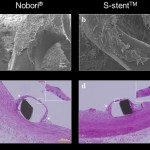
Noboriとその原型となったベアメタルステント(S-stent)をブタ冠動脈に留置し、2日後と14日後における内皮化を比較検討しました。HE染色、蛍光免疫染色、走査型電子顕微鏡(SEM)で形態観察および組織学的解析を行ったところ、ステント留置2日後には、ステントは新生内膜で部分的に被覆されており、特にHE染色標本では形態学的に内皮化を示唆する血管内皮細胞が確認されました(図1)。そこで、内皮細胞の存在を確認するために蛍光免疫染色を行ったところ、von Willebrand factor、VE-Cadherin、KDR/VEGFR2においてそれぞれで陽性となり、内皮細胞の存在が証明されました。
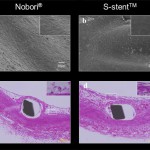
さらに、ステント留置14日後には、ステントは新生内膜で完全に被覆されていました(図2)。組織学的解析では、NoboriはS-stentと比較して、14日後における新生内膜の増殖が有意に抑制されており、一方で炎症反応はNoboriで有意に高いことが分かりました。つまり、Noboriはベアメタルステントと同様に留置後早期に新生内膜の増殖が起こり、その増殖は薬剤により適切に抑制されていたと考えられます。
今後の展望
臨床的な応用としては、Noboriでは早期に内皮化が起こることが確認されたので、ステント留置後に必要な抗血小板薬2剤の内服期間を短縮できる可能性が示唆されます。また、超急性期のステント内血栓症の予防効果にアドバンテージがあると考えられます。これらの特性がアウトカムに反映されるかは更なる臨床試験が必要であり、今後、橋渡し研究として取り組んでいく予定です。








